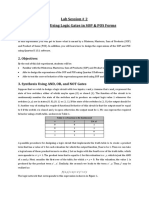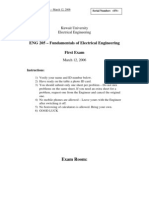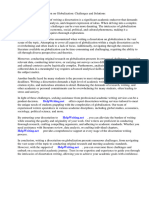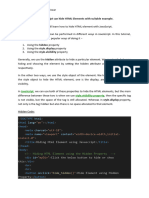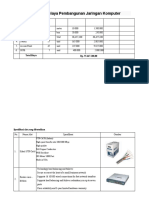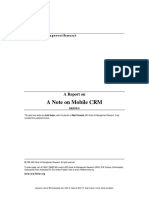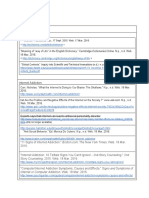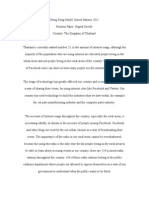Introduction
Chapter 1
Computer Networks, Fifth Edition by Andrew Tanenbaum and David Wetherall, Pearson Education-Prentice Hall, 2011
�Uses of Computer Networks
Business Applications Home Applications Mobile Users Social Issues
Computer Networks, Fifth Edition by Andrew Tanenbaum and David Wetherall, Pearson Education-Prentice Hall, 2011
�Business Applications (1)
A network with two clients and one server
Computer Networks, Fifth Edition by Andrew Tanenbaum and David Wetherall, Pearson Education-Prentice Hall, 2011
�Business Applications (2)
The client-server model involves requests and replies
Computer Networks, Fifth Edition by Andrew Tanenbaum and David Wetherall, Pearson Education-Prentice Hall, 2011
�Home Applications (1)
In a peer-to-peer system there are no fixed clients and servers.
Computer Networks, Fifth Edition by Andrew Tanenbaum and David Wetherall, Pearson Education-Prentice Hall, 2011
�Home Applications (2)
Some forms of e-commerce
Computer Networks, Fifth Edition by Andrew Tanenbaum and David Wetherall, Pearson Education-Prentice Hall, 2011
�Mobile Users
Combinations of wireless networks and mobile computing
Computer Networks, Fifth Edition by Andrew Tanenbaum and David Wetherall, Pearson Education-Prentice Hall, 2011
�Social Issues
Network neutrality Digital Millennium Copyright Act Profiling users Phishing
Computer Networks, Fifth Edition by Andrew Tanenbaum and David Wetherall, Pearson Education-Prentice Hall, 2011
�Network Hardware (1)
Personal area networks Local area networks Metropolitan area networks Wide are networks The internet
Computer Networks, Fifth Edition by Andrew Tanenbaum and David Wetherall, Pearson Education-Prentice Hall, 2011
�Network Hardware (2)
Classification of interconnected processors by scale.
Computer Networks, Fifth Edition by Andrew Tanenbaum and David Wetherall, Pearson Education-Prentice Hall, 2011
�Personal Area Network
Bluetooth PAN configuration
Computer Networks, Fifth Edition by Andrew Tanenbaum and David Wetherall, Pearson Education-Prentice Hall, 2011
�Local Area Networks
Wireless and wired LANs. (a) 802.11. (b) Switched Ethernet.
Computer Networks, Fifth Edition by Andrew Tanenbaum and David Wetherall, Pearson Education-Prentice Hall, 2011
�Metropolitan Area Networks
A metropolitan area network based on cable TV.
Computer Networks, Fifth Edition by Andrew Tanenbaum and David Wetherall, Pearson Education-Prentice Hall, 2011
�Wide Area Networks (1)
WAN that connects three branch offices in Australia
Computer Networks, Fifth Edition by Andrew Tanenbaum and David Wetherall, Pearson Education-Prentice Hall, 2011
�Wide Area Networks (2)
WAN using a virtual private network.
Computer Networks, Fifth Edition by Andrew Tanenbaum and David Wetherall, Pearson Education-Prentice Hall, 2011
�Wide Area Networks (3)
WAN using an ISP network.
Computer Networks, Fifth Edition by Andrew Tanenbaum and David Wetherall, Pearson Education-Prentice Hall, 2011
�Network Software
Protocol hierarchies Design issues for the layers Connection-oriented versus connectionless service Service primitives Relationship of services to protocols
Computer Networks, Fifth Edition by Andrew Tanenbaum and David Wetherall, Pearson Education-Prentice Hall, 2011
�Protocol Hierarchies (1)
Layers, protocols, and interfaces.
Computer Networks, Fifth Edition by Andrew Tanenbaum and David Wetherall, Pearson Education-Prentice Hall, 2011
�Protocol Hierarchies (2)
The philosopher-translator-secretary architecture
Computer Networks, Fifth Edition by Andrew Tanenbaum and David Wetherall, Pearson Education-Prentice Hall, 2011
�Protocol Hierarchies (3)
Example information flow supporting virtual communication in layer 5.
Computer Networks, Fifth Edition by Andrew Tanenbaum and David Wetherall, Pearson Education-Prentice Hall, 2011
�Connection-Oriented Versus Connectionless Service
Six different types of service.
Computer Networks, Fifth Edition by Andrew Tanenbaum and David Wetherall, Pearson Education-Prentice Hall, 2011
�Service Primitives (1)
Six service primitives that provide a simple connection-oriented service
Computer Networks, Fifth Edition by Andrew Tanenbaum and David Wetherall, Pearson Education-Prentice Hall, 2011
�Service Primitives (2)
A simple client-server interaction using acknowledged datagrams.
Computer Networks, Fifth Edition by Andrew Tanenbaum and David Wetherall, Pearson Education-Prentice Hall, 2011
�The Relationship of Services to Protocols
The relationship between a service and a protocol.
Computer Networks, Fifth Edition by Andrew Tanenbaum and David Wetherall, Pearson Education-Prentice Hall, 2011
�Reference Models
OSI reference model TCP/IP reference model Model used for this text Comparison of OSI and TCP/IP Critique of OSI model and protocols Critique of TCP/IP model
Computer Networks, Fifth Edition by Andrew Tanenbaum and David Wetherall, Pearson Education-Prentice Hall, 2011
�The OSI Reference Model
Principles for the seven layers Layers created for different abstractions Each layer performs well-defined function Function of layer chosen with definition of international standard protocols in mind Minimize information flow across interfaces between boundaries Number of layers optimum
Computer Networks, Fifth Edition by Andrew Tanenbaum and David Wetherall, Pearson Education-Prentice Hall, 2011
�The OSI Reference Model
The OSI reference model
Computer Networks, Fifth Edition by Andrew Tanenbaum and David Wetherall, Pearson Education-Prentice Hall, 2011
�OSI Reference Model Layers
Physical layer Data link layer Network layer Transport layer Session layer Presentation layer Application layer
Computer Networks, Fifth Edition by Andrew Tanenbaum and David Wetherall, Pearson Education-Prentice Hall, 2011
�The TCP/IP Reference Model Layers
Link layer Internet layer Transport layer Application layer
Computer Networks, Fifth Edition by Andrew Tanenbaum and David Wetherall, Pearson Education-Prentice Hall, 2011
�The TCP/IP Reference Model (1)
The TCP/IP reference model
Computer Networks, Fifth Edition by Andrew Tanenbaum and David Wetherall, Pearson Education-Prentice Hall, 2011
�The TCP/IP Reference Model (2)
The TCP/IP reference model with some protocols we will study
Computer Networks, Fifth Edition by Andrew Tanenbaum and David Wetherall, Pearson Education-Prentice Hall, 2011
�The Model Used in this Book
The reference model used in this book.
Computer Networks, Fifth Edition by Andrew Tanenbaum and David Wetherall, Pearson Education-Prentice Hall, 2011
�Comparison of the OSI and TCP/IP Reference Models
Concepts central to OSI model Services Interfaces Protocols
Computer Networks, Fifth Edition by Andrew Tanenbaum and David Wetherall, Pearson Education-Prentice Hall, 2011
�Critique of the OSI Model and Protocols
Bad timing. Bad technology. Bad implementations. Bad politics.
Computer Networks, Fifth Edition by Andrew Tanenbaum and David Wetherall, Pearson Education-Prentice Hall, 2011
�OSI Model Bad Timing
The apocalypse of the two elephants.
Computer Networks, Fifth Edition by Andrew Tanenbaum and David Wetherall, Pearson Education-Prentice Hall, 2011
�Example Networks
Internet ARPANET NSFNET Third-generation mobile phone networks Wireless LANs: 802.11 RFID and sensor networks
Computer Networks, Fifth Edition by Andrew Tanenbaum and David Wetherall, Pearson Education-Prentice Hall, 2011
�The ARPANET (1)
a) b)
Structure of the telephone system. Barans proposed distributed switching system.
Computer Networks, Fifth Edition by Andrew Tanenbaum and David Wetherall, Pearson Education-Prentice Hall, 2011
�The ARPANET (2)
The original ARPANET design
Computer Networks, Fifth Edition by Andrew Tanenbaum and David Wetherall, Pearson Education-Prentice Hall, 2011
�The ARPANET (3)
Growth of the ARPANET. a) December 1969. b) July 1970. c) March 1971.
Computer Networks, Fifth Edition by Andrew Tanenbaum and David Wetherall, Pearson Education-Prentice Hall, 2011
�The ARPANET (4)
Growth of the ARPANET. d) April 1972. e) September 1972.
Computer Networks, Fifth Edition by Andrew Tanenbaum and David Wetherall, Pearson Education-Prentice Hall, 2011
�NSFNET
The NSFNET backbone in 1988.
Computer Networks, Fifth Edition by Andrew Tanenbaum and David Wetherall, Pearson Education-Prentice Hall, 2011
�Architecture of the Internet
Overview of the Internet architecture
Computer Networks, Fifth Edition by Andrew Tanenbaum and David Wetherall, Pearson Education-Prentice Hall, 2011
�Third-Generation Mobile Phone Networks (1)
Cellular design of mobile phone networks
Computer Networks, Fifth Edition by Andrew Tanenbaum and David Wetherall, Pearson Education-Prentice Hall, 2011
�Third-Generation Mobile Phone Networks (2)
Architecture of the UMTS 3G mobile phone network.
Computer Networks, Fifth Edition by Andrew Tanenbaum and David Wetherall, Pearson Education-Prentice Hall, 2011
�Third-Generation Mobile Phone Networks (3)
Mobile phone handover (a) before, (b) after.
Computer Networks, Fifth Edition by Andrew Tanenbaum and David Wetherall, Pearson Education-Prentice Hall, 2011
�Wireless LANs: 802.11 (1)
(a) Wireless network with an access point. (b) Ad hoc network.
Computer Networks, Fifth Edition by Andrew Tanenbaum and David Wetherall, Pearson Education-Prentice Hall, 2011
�Wireless LANs: 802.11 (2)
Multipath fading
Computer Networks, Fifth Edition by Andrew Tanenbaum and David Wetherall, Pearson Education-Prentice Hall, 2011
�Wireless LANs: 802.11 (3)
The range of a single radio may not cover the entire system.
Computer Networks, Fifth Edition by Andrew Tanenbaum and David Wetherall, Pearson Education-Prentice Hall, 2011
�RFID and Sensor Networks (1)
RFID used to network everyday objects.
Computer Networks, Fifth Edition by Andrew Tanenbaum and David Wetherall, Pearson Education-Prentice Hall, 2011
�RFID and Sensor Networks (2)
Multihop topology of a sensor network
Computer Networks, Fifth Edition by Andrew Tanenbaum and David Wetherall, Pearson Education-Prentice Hall, 2011
�Network Standardization
Whos Who in telecommunications Whos Who in international standards Whos Who in internet standards
Computer Networks, Fifth Edition by Andrew Tanenbaum and David Wetherall, Pearson Education-Prentice Hall, 2011
�Whos Who in International Standards (1)
The 802 working groups. The important ones are marked with *. The ones marked with are hibernating. The one marked with gave up and disbanded itself.
Computer Networks, Fifth Edition by Andrew Tanenbaum and David Wetherall, Pearson Education-Prentice Hall, 2011
�Whos Who in International Standards (2)
The 802 working groups. The important ones are marked with *. The ones marked with are hibernating. The one marked with gave up and disbanded itself.
Computer Networks, Fifth Edition by Andrew Tanenbaum and David Wetherall, Pearson Education-Prentice Hall, 2011
�Metric Units (1)
The principal metric prefixes
Computer Networks, Fifth Edition by Andrew Tanenbaum and David Wetherall, Pearson Education-Prentice Hall, 2011
�Metric Units (2)
The principal metric prefixes
Computer Networks, Fifth Edition by Andrew Tanenbaum and David Wetherall, Pearson Education-Prentice Hall, 2011
�End
Chapter 1
Computer Networks, Fifth Edition by Andrew Tanenbaum and David Wetherall, Pearson Education-Prentice Hall, 2011





